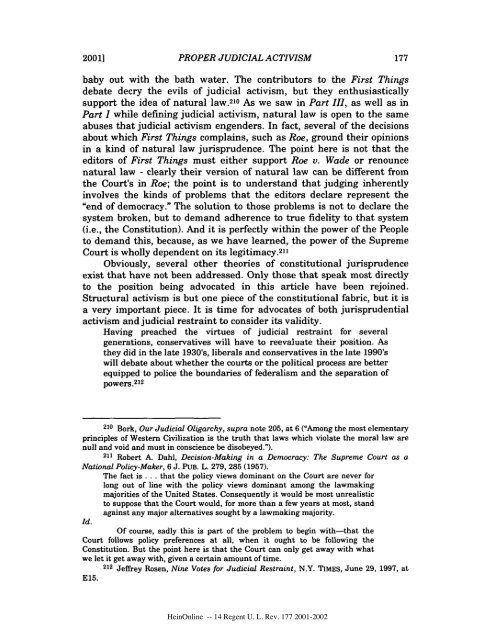Judicial ReEngineering
Judicial ReEngineering
Judicial ReEngineering
Create successful ePaper yourself
Turn your PDF publications into a flip-book with our unique Google optimized e-Paper software.
2001]<br />
PROPER JUDICIAL ACTIVISM<br />
baby out with the bath water. The contributors to the First Things<br />
debate decry the evils of judicial activism, but they enthusiastically<br />
support the idea of natural law.210 As we saw in Part III, as well as in<br />
Part I while defining judicial activism, natural law is open to the same<br />
abuses that judicial activism engenders. In fact, several of the decisions<br />
about which First Things complains, such as Roe, ground their opinions<br />
in a kind of natural law jurisprudence. The point here is not that the<br />
editors of First Things must either support Roe v. Wade or renounce<br />
natural law - clearly their version of natural law can be different from<br />
the Court's in Roe; the point is to understand that judging inherently<br />
involves the kinds of problems that the editors declare represent the<br />
"end of democracy." The solution to those problems is not to declare the<br />
system broken, but to demand adherence to true fidelity to that system<br />
(i.e., the Constitution). And it is perfectly within the power of the People<br />
to demand this, because, as we have learned, the power of the Supreme<br />
Court is wholly dependent on its legitimacy. 21 '<br />
Obviously, several other theories of constitutional jurisprudence<br />
exist that have not been addressed. Only those that speak most directly<br />
to the position being advocated in this article have been rejoined.<br />
Structural activism is but one piece of the constitutional fabric, but it is<br />
a very important piece. It is time for advocates of both jurisprudential<br />
activism and judicial restraint to consider its validity.<br />
Having preached the virtues of judicial restraint for several<br />
generations, conservatives will have to reevaluate their position. As<br />
they did in the late 1930's, liberals and conservatives in the late 1990's<br />
will debate about whether the courts or the political process are better<br />
equipped to police the boundaries of federalism and the separation of<br />
powers. 212<br />
210 Bork, Our <strong>Judicial</strong> Oligarchy, supra note 205, at 6 ("Among the most elementary<br />
principles of Western Civilization is the truth that laws which violate the moral law are<br />
null and void and must in conscience be disobeyed.").<br />
211 Robert A. Dahl, Decision-Making in a Democracy: The Supreme Court as a<br />
National Policy-Maker, 6 J. PUB. L. 279, 285 (1957).<br />
The fact is ... that the policy views dominant on the Court are never for<br />
long out of line with the policy views dominant among the lawmaking<br />
majorities of the United States. Consequently it would be most unrealistic<br />
to suppose that the Court would, for more than a few years at most, stand<br />
against any major alternatives sought by a lawmaking majority.<br />
Id.<br />
Of course, sadly this is part of the problem to begin with-that the<br />
Court follows policy preferences at all, when it ought to be following the<br />
Constitution. But the point here is that the Court can only get away with what<br />
we let it get away with, given a certain amount of time.<br />
212 Jeffrey Rosen, Nine Votes for <strong>Judicial</strong> Restraint, N.Y. TIMES, June 29, 1997, at<br />
HeinOnline -- 14 Regent U. L. Rev. 177 2001-2002

















